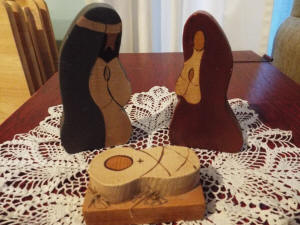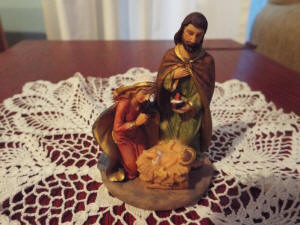|
 In 1223 St. Francis of Assisi was concerned that the emphasis of
Christmas was upon materialism, gift giving and secular traditions.
In an attempt to impact people to worship Christ, St. Francis
created a live nativity scene in a cave in Greccio, Italy. He
invited people to come gaze upon the scene as he preached about the
babe of Bethlehem. This first nativity scene staged Mary, Joseph,
and baby Jesus with an ox and a donkey. The scene's popularity
inspired much imitation throughout the world. Hundreds of years
later, a nativity could be found in every church in Italy. In 1223 St. Francis of Assisi was concerned that the emphasis of
Christmas was upon materialism, gift giving and secular traditions.
In an attempt to impact people to worship Christ, St. Francis
created a live nativity scene in a cave in Greccio, Italy. He
invited people to come gaze upon the scene as he preached about the
babe of Bethlehem. This first nativity scene staged Mary, Joseph,
and baby Jesus with an ox and a donkey. The scene's popularity
inspired much imitation throughout the world. Hundreds of years
later, a nativity could be found in every church in Italy.
Of the four gospels in the New Testament, only two describe Jesus'
birth. Luke describes an angel announcing the birth of Jesus to
shepherds, who then visit the humble site where Jesus is found lying
in a manger:


“And there were shepherds living
out in the fields nearby, keeping watch over their flocks at night.
An angel of the Lord appeared to them,
and the glory of the Lord shone around them, and they were
terrified.
But the angel said to them, 'Do not be afraid. I bring you good news
of great joy that will be for all the people.
Today in the town of David a Savior has been born to you; he is
Christ the Lord.
This will be a sign to you:
You will find a baby wrapped in cloths and lying in a manger.'
Suddenly a great company of heavenly host appeared with the angel,
praising God and saying, 'Glory to God in the highest,
and on earth peace to men on whom his
favor rests.”
---Luke 2: 8-14 (NIV)
Matthew tells the story of Magi who followed a star until they found
the child with his mother, Mary:

“After Jesus was born in
Bethlehem in Judea, during the time of King Herod,
Magi from the east came to Jerusalem and asked, 'Where is the one
who has been born king of the Jews? We saw his star in the east and
have come to worship him.'
When King Herod heard this he was
disturbed, and all Jerusalem with him.
When he had called together all the people's chief priests and
teachers of the law,
he asked them where the Christ was to be born.
'In Bethlehem in Judea,' they replied,
'for this is what the prophet has written:
But you, Bethlehem, in the land of Judah,
are by no means least among the rulers of Judah, for out of you will
come a ruler
who will be the shepherd of my people Israel.'
Then Herod called the Magi secretly
and found out the exact time the star had appeared.
He sent them to Bethlehem and said, 'Go and make a careful search
for the child.
As soon as you find him, report to me, so that I too may go and
worship him.'
After they had heard the king, they went on their way and the star
they had seen in the east went ahead of them, until it stopped over
the place where the child was.
When they saw the star, they were overjoyed.
On coming to the house, they saw the child with his mother Mary, and
they bowed down and worshiped him.
Then they opened their treasures and presented him with gifts of
gold and of incense and of myrrh.
And having been warned in a dream not to go back to Herod, they
returned to their country by another route.”
---Matthew 2: 1-12 (NIV)
Two perspectives of the same story. Neither account tells of the
shepherds and wise men being at the manger at the same time. No
where in the Bible are donkeys, oxen, or cattle mentioned being at
the birth place of the baby. The nativity scene may not be accurate
according to these Bible accounts, but during the Christmas season
the nativity brings comfort and peace to people all over the world.
[to top of second column] |

Toni Reifsteck has been collecting nativity sets with her husband, Wallace, for
over 59 years. They have collected nativity sets from all over the world,
including the Holy Lands. The collection includes nativities carved out of wood,
stained glass, ceramic, plaster, pewter, marble, and more. When they got
married, Wallace had the nativity his sister gave him as a gift at the time of
his confirmation. With that as inspiration, Toni made a nativity set for each of
her five children at the time of their confirmation.
The story continues as Toni makes nativity sets for each of her grandchildren.
The Reifsteck family has a tradition of displaying the nativity but not putting
the baby in the manger until Christmas. Toni is fully aware of the Bible
discrepancies and religious differences when it comes to the nativity, but
according to Toni, “The nativity is all about faith.” Toni and Wallace leave
three or four nativity sets up all year as a reminder of the love of Christ.
Judy Kukuck says the nativity reminds her family of the redemption story. Christ
came as a babe to earth in order to heal our broken lives. He was later
crucified and rose from the dead so we could be free from the bondage of sin.
“The story starts with the nativity.” She started collecting nativities several
years ago because she likes them. Judy and her husband, Dean, collect nativities
as they travel. She, too, leaves several nativity scenes out all year as a
reminder to her family that the “story does not end in the manger.”

To Donna Twist, the nativity is a reminder that, “God so loved the world that he
gave his one and only Son, that whoever believes in him shall not perish but
have eternal life.” John 3:16 (NIV)
God could have come to earth as a king with the majesty and honors that he
deserved. He could have been born in a palace with the finest of everything.
Instead, he was born a poor child of a virgin in a stable. The nativity is the
beginning of her belief of salvation.

Christmas time is special to different people for different reasons, but for
those who believe in the nativity, despite the differences from country to
country, region to region, and family to family, Christmas has a special
meaning; a reminder of the gift of God's son, given so many years ago. Christmas
is more than fire, hot chocolate, lights, sleigh rides, or singing carols. It is
a celebration of the birth of our Savior, our Messiah, our Redeemer. This
Christmas season may we find the nativity comforting and remember to worship
Christ, the babe in the manger.

|